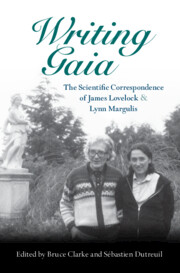When her first letter arrived in 1970, Lovelock’s personal research program on planetary atmospheres, then developing through a concept he has privately named “Gaia,” had already taken on a fair amount of definition. He informed her, “I am in the course of writing a paper on the Earth’s atmosphere as a biological cybernetic system” (Letter 1). This striking formulation of a biological cybernetic system is the curt technical description for which “Gaia” will become the shorthand trademark. This phrase was already present in a paper written on behalf of NASA, delivered in 1968 at a meeting of the American Astronautical Society and published in 1969, “Planetary atmospheres: compositional and other changes associated with the presence of life” (see Letters 5 and 9).
In this presentation Lovelock suggested that NASA’s planetary exploration program had already discovered that a “living Earth” constitutes a system, and that this formal and functional recognition regarding our own planet rivaled the importance of NASA’s ostensible mission of detecting life on other planets:
The planetary exploration program has already contributed in many ways to the better understanding of the Earth as a planet. If it can succeed in revealing in full detail the biological cybernetic system of the Earth’s atmosphere, this would seem to be a role nearly as important as the discovery of life elsewhere. Even if the other planets, Mars and Venus, show no evidence of life, their composition and properties still represent important reference points of abiological steady state equilibria against which the living Earth can be compared.
Lovelock’s work on life-detection schemes for NASA in the 1960s was a major impetus behind the first drafts of the Gaia hypothesis. This same paper already approaches a recognizable version of the Gaia concept, but it does so through a lively mix of standard disciplinary terms. The science of life-detection applied to Earth is a “comparatively new subject, planetary ecology, with particular reference to the planetary ecosystem which includes all of the life on Earth … the maximum unit of life” (180). We read the “planetary ecosystem” today as the Gaian system.
Letter 1 gives this unusual description the unconventional construction sketched in that 1969 article: “I am now tolerably certain that all of the components of the Earth’s atmosphere other than the rare gases and perhaps water vapour are biologically maintained.” His thesis regarding the largely biological nature of both the composition and the stability of the Earth’s atmosphere challenges an earlier consensus that sees “the present composition of the Earth’s atmosphere as the end result of the working of abiological” – or strictly geological – “processes” (Lovelock and Lodge Reference Lovelock and Lodge1972: 575). Lovelock and Margulis immediately shared a conviction that the biosphere had a larger role in the affairs of the geosphere than traditionally accorded. Lovelock was already building up the Gaian view of tight coupling between the atmosphere and the biosphere that keeps molecular composition within a narrow range of viable states, “and this of course includes nitrogen.” As Lovelock and Lodge argue, the presence of atmospheric nitrogen (N2) is also a “life indicator” (Reference Lovelock and Lodge1972: 575). Thus, if life were deleted from the contemporary Earth, nitrogen may be chemically pulled out of circulation, leaving only a trace in the air. Thought experiments based on the deletion of life from the present Earth would become a standard Gaian talking point.
*
* *
1. James Lovelock to Lynn Margulis, September 11, 1970
Dear Dr. Margulis,
Thank you very much for your letter and papers on Early Cellular Evolution; these I found most interesting.
I am in the course of writing a paper on the Earth’s atmosphere as a biological cybernetic system. My comments on yours and a draft copy I’ll send when it is ready, which should not be later, I hope, than the next few weeks.
I am now tolerably certain that all of the components of the Earth’s atmosphere other than the rare gases and perhaps water vapour are biologically maintained and this of course includes nitrogen.Footnote 36
I shall be paying a visit to JPL towards the end of September and maybe can give you a call from there.
Yours sincerely



